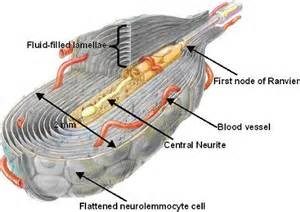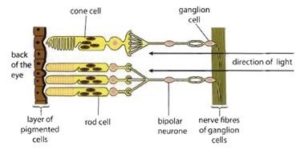Organisms respond to changes in their internal and external environments (AQA A2 Biology) PART 2 of 9 TOPICS
|
Receptors:
The simple of a Pacinian corpuscle should be known which is illustrated below.
Receptors are specific as they only respond to specific stimuli. An example is the Pacinian corpuscle which is a mechanoreceptor that only responds to mechanical stimuli. The connective tissue round the neurone ending deforms when pressure is applied opening the stretch-mediated sodium ion channels. This causes an influx of Na+ ions into the axon and depolarising the axon membrane. The change in potential difference up to this point is called the generator potential. If the threshold is met an action potential is created.
Rods and cones are found in the photosensitive layer in the peripheral area of the eye. The pigments, sensitivity to light, acuity and sensitivity to colour must be known of rods and cones to identify any differences:
RODS: (Pigment – rhodopsin, high sensitivity to light, low acuity, low sensitivity to colour)
- Pigments: Rods contain a pigment called rhodopsin.
- Sensitivity to light: Many rods are connected to one nerve fibre by spatial summation. Light can be detected from a wide area and the combination of these stimulatory effects of each rod makes them sensitive.
- Acuity: Because of spatial summation, each rod will have a different stimulatory effect. These are then combined into one image by the brain which comes out in a blur.
- Sensitivity to colour: Only one type of pigment is found in all of rods and lets us see things in black and white. An example is in the dark where the rods are only in use and not cones. Not much colour can be seen.
CONES: (Pigment – iodopsin, low sensitivity to light, high acuity, high sensitivity to colour)
- Pigments: Cones contain one type of the three types of pigment called iodopsin.
- Sensitivity to light: Only one cone is attached to its own nerve and so there is only stimulatory effect created.
- Acuity: Cones are not connected to each other which means only one impulse travels from one cone to make one image therefore the image is more clear.
- Sensitivity to colour: Each type of the three types of pigments is found in one cone and is responsible for one of the three primary colours (blue, green and red). The pigment is bleached when light at a certain wavelength corresponds to the colour.


